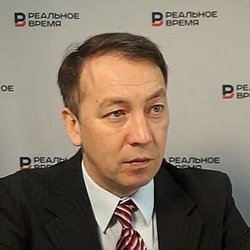Experts name factors of pressure on ruble rate and dispel rumours about new devaluation
While the national currency has weakened compared to the dollar and euro, rumour has it in Russia that a big ruble devaluation is looming. Realnoe Vremya tried to find out together with experts what is influencing a currency rate now what factors will press it next autumn and if the Russian authorities are trying to support exports by deliberately weakening the ruble.
Geopolitics, not oil
The ruble held around 75,05 per dollar at 10 September’s currency tradings, while it reached 74,67 per dollar since last Wednesday for the first time. The Russian currency has cheapened a bit against the euro — to 89,06, however, it didn’t go over 90 like a few days ago. So volatility in the Russian currency market is growing.
The general situation in general can hardly be called catastrophic, but oil has gone down again (though it has a way to reach the spring activity), geopolitical factors also add some uncertainties. If we consider the history of the last three months, the ruble has lost about 10% against the dollar and 15% against the euro. And this fall primarily has nothing to do with even the adventures of oil (that aren’t very rich this summer) but sanction-related risks, expectations of the US presidential election and Belarusian events. Most experts agree that non-residents’ withdrawal from non-ruble assets adds some negativity to the position of the Russian currency (they are afraid of precisely geopolitical uncertainties). While rumours about an intended devaluation have been discussed in the information space for several weeks already: the Russian authorities allegedly want to support exporters and are not taking measures to keep the ruble rate, in contrast, they are following a soft policy to cheapen their currency.
The rumours about the upcoming devaluation are enervating not currency speculators at exchanges but ordinary Russians who shiver almost every August and wait for currency shocks (for instance, like the one in 2008). This influences a lot of processes, for instance, the realty market: Kazan citizens are buying flats for fear of losing their savings in the fire of devaluation. However, the experts surveyed by Realnoe Vremya agree that there won’t be devaluation, either scheduled or spontaneous.
Exporters shouldn’t be rescued
Yevgeny Nadroshin, chief economist at PF Capital, dispels the rumours about the salvation of oil companies by deliberately weakening the ruble. In his opinion, the enterprises are working for the domestic market and importers should be rescued. He explains that the ruble rate fell because imports are recovering after the pandemic, which takes place accordingly the economic revival:

Vladislav Kochetkov, president of Finam GC, is also sure that all the current occurrences are absolutely natural market processes, which, however, the Russian monetary authorities aren’t restraining because they are anyway beneficial for the budget.
“There is no intended devaluation for sure because we see that gold reserves of the country are stable, that’s to say, the authorities aren’t injecting money to the market. Moreover, capital is withdrawn outside the country — we’ve recently talked that non-residents are withdrawing money, this process goes on. There are several reasons for this — from the expectation of volatility amid the American election to the Navalny factor that can turn into new sanctions. There aren’t any intended interventions, it is a natural market process. I am not sure if it will be positive.”
“It is total craziness to allow sudden devaluation from a political perspective”
Economist and blogger Albert Bikbov pays attention to political risks that intended devaluation would have entailed:

Nataliya Orlova, chief economist, director of Macroeconomic Analysis Centre at Alfa-Bank, repeats her points that a fall in the ruble rate is an ordinary occurrence when the currency has a floating rate, which is determined by the market, not the desire of the government, exporters or even the Central Bank.
“Such rumours appear once in several years, whenever the ruble rate falls. When the rate’s direction changes very much, one wants to see some hidden meaning. One starts saying that somebody benefits from it. And when the ruble rate gets stronger, no rumours appear because this trajectory doesn’t have any explanation. The currency market works differently in reality. We have a floating rate. The Central Bank isn’t keeping the market rate, nobody is pushing it either upwards or downwards. The regulator simply reserves the right to temporarily appear in the market when there is some force majeure and the equilibrium rate deviates. For instance, when the equilibrium rate is 70-72 rubles, if we assume that exporters will stop selling the currency in the market for some reason, and some investors will start escaping the Russian market, and the rate is 90, this scenario turns on the mechanism of financial stability, but this scenario has nothing to do with the economy’s fundamental situation. And this doesn’t mean that the Central Bank is ‘adjusting’ this situation every day.”
Andrey Movchan, head of Moscow Carnegie Center’s economic programme, agrees with his colleagues:

US presidential election as a risk factor for rubles
Vladislav Kochetkov thinks that the ruble’s high volatility will inevitably stay till the US election. He considers that any claim, any change in Biden and Trump’s positions by a couple of percentage points will be negative for the ruble.

Almost everyone agrees with the fact that the election in the USA will have an impact on the ruble. Another thing is the result of this election. For example, Albert Bikbov is quite sceptical: in his opinion, “the fight that’s taking place now between the candidates is absolutely fantastic, it won’t end well for America. The defeated side will try to take its revenge, and it will be an unusual election, to put it mildly.” In any case, the dollar will be in a fever, and the ruble will follow it.
Experts don’t forecast rate to go above 85 rubles per dollar
Most experts agree that the rest of the geopolitical factors is still enervating the market, for instance, Belarus has almost stopped influencing the ruble rate. Albert Bikbov characterises the neighbours’ situation as “sluggish”. As for the situation with Navalny, Andrey Movchan, for instance, is sure that it has nothing to do with what’s happening to the ruble (“It is very unpleasant but it doens’t influence the currency market”). The other economists are more cautious: this story can theoretically cause a new turn of sanctions.
But most specialists agree on what will be happening next: there won’t be big devaluation, there aren’t prerequisites for it.
“Things aren’t that bad,” Bikbov says. “The specialists aren’t waiting for the situation in April and May in the oil market to repeat and, consequently, the currency rate can’t change suddenly. I am personally optimistic about things: the economy is going up, the sectors are recovering, people are starting to meet pent-up demand. The situation in the Russian economy in general is better than in the European or American, therefore I don’t see prerequisites for the collapse of the ruble. I expect the dollar rate to be around 80-82 rubles by the end of the year.”
Andrey Movchan isn’t in general ready to make specific forecasts — the situation is too volatile now:
“I’ve never tried to forecast the currency rate because the situation is very volatile now. There is more than a 50% probability that it will be higher than now, but it won’t be possible to claim anything specific.”
Nataliya Orlova forecasts the most optimistic scenario for the ruble among all the specialists surveyed by Realnoe Vremya:

Yevgeny Nadorshin considers the ruble rate will be from 80 to 85 rubles against the dollar by the end of the year:
“If some political or other factors influence, I think that 80 rubles per dollar with oil at $40-45 per barrel is a normal rate we will see this year. If oil falls to $30 (which is very probable I think), we will see 85 rubles per dollar. Factors like sanctions can worsen this situation.”
Vladislav Kochetkov bets on strong sides of the economy that survived the coronavirus pandemic better than many others:
“Given the current situation in the economy, we expect the dollar to be at 70-73 by the end of the year, below today’s levels. If we base on fundamental factors, the ruble is resold now, and considering the state of our economy, it is too cheap. This is why we see prerequisites for its strengthening. I don’t expect a big devaluation, big collapse of the ruble like the one we experienced earlier.”